How ‘Futurama’ Became the Show That Won’t Stay Dead
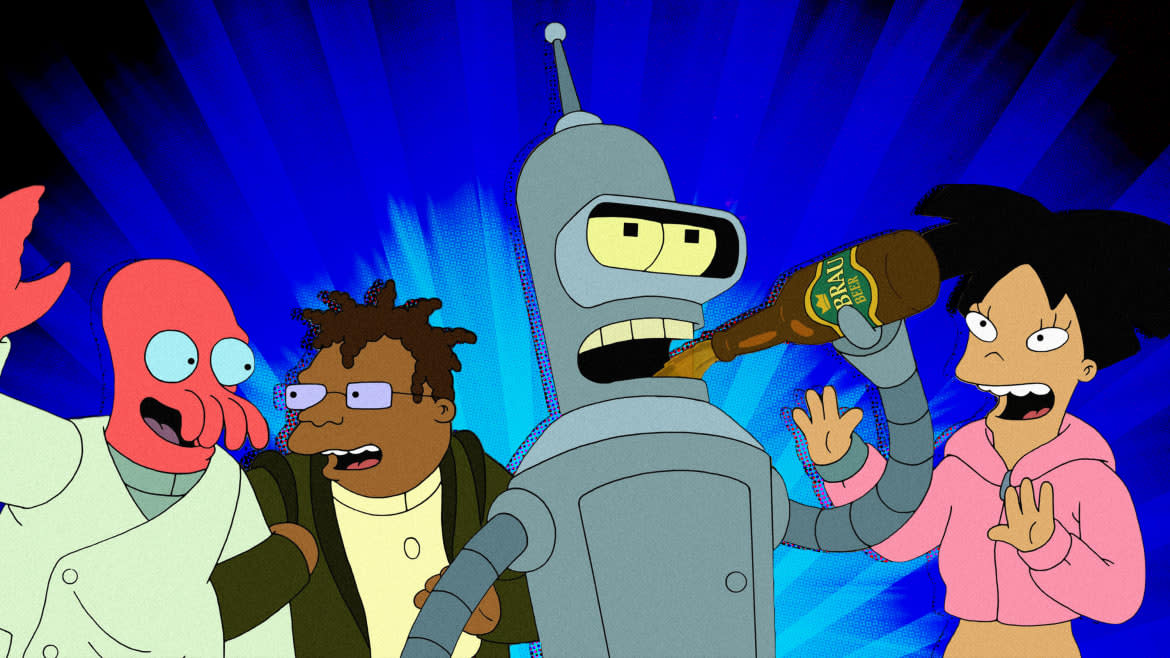
- Oops!Something went wrong.Please try again later.
- Oops!Something went wrong.Please try again later.
- Oops!Something went wrong.Please try again later.
Good news, everyone! After a 10-year spell in a cryo-tube, Futurama has finally been defrosted and delivered back into our eyeballs. Debuting on Hulu Monday, July 24, Matt Groening and David X. Cohen’s regularly-rebirthing space comedy that just won’t die makes a triumphant return after being canceled twice by two different networks.
Originally airing on Fox in 1999, Futurama ran for four seasons before the studio jettisoned it into an inky void of cancellation and reruns. Healthy repeat-viewing numbers on Cartoon Network’s Adult Swim block led Comedy Central to commission four direct-to-DVD movies in 2008 and, later, two more seasons. By 2013, however, the network too decided to ditch the show and leave the Planet Express crew to fend for themselves. Turns out, they did pretty well at that in an age of streaming—enough to convince Hulu to revive Futurama for another rebirth, complete with 20 episodes across two seasons.
Needless to say, keeping up with the adventures of Fry (Billy West), the hapless delivery boy who gets cryogenically frozen in 1999, only to reawaken in the year 3000 and meet cyclops love interest Leela (Katey Sagal), binge-drinking robot Bender (John DiMaggio), ancient Professor Farnsworth (also West) and the rest of the Planet Express team, has been a bit of a rollercoaster. In fact, even its Hulu regeneration hasn’t been without a few teething problems.
Good News, Everyone! Hulu Is Reviving Cult-Favorite Animated Series ‘Futurama’
Shortly after it was confirmed in February 2022, DiMaggio initially refused to return in an attempt to bag a better deal for himself and his fellow voice actors, a move that foreshadowed the currently ongoing WGA/SAG-AFTRA strike plaguing Hollywood. Ultimately, DiMaggio returned without securing a bigger paycheck, but he did succeed in drawing attention to the very topical issue of paying creatives appropriately for the services they provide. With Bender back, Futurama could officially return from the dead for a third time after four would-be finales.
For the creatives behind it, its latest relaunch couldn’t have come soon enough.
“Fifteen years ago, I used to say I’d be happy to spend the rest of my career working on Futurama—then it got canceled,” deadpans Peter Avanzino, long-time series director at Rough Draft Studios, the Californian animation house that brings the series to life. “We worked on a lot of stuff in the meantime, and for the most part it was all pretty good. But it wasn’t Futurama.”
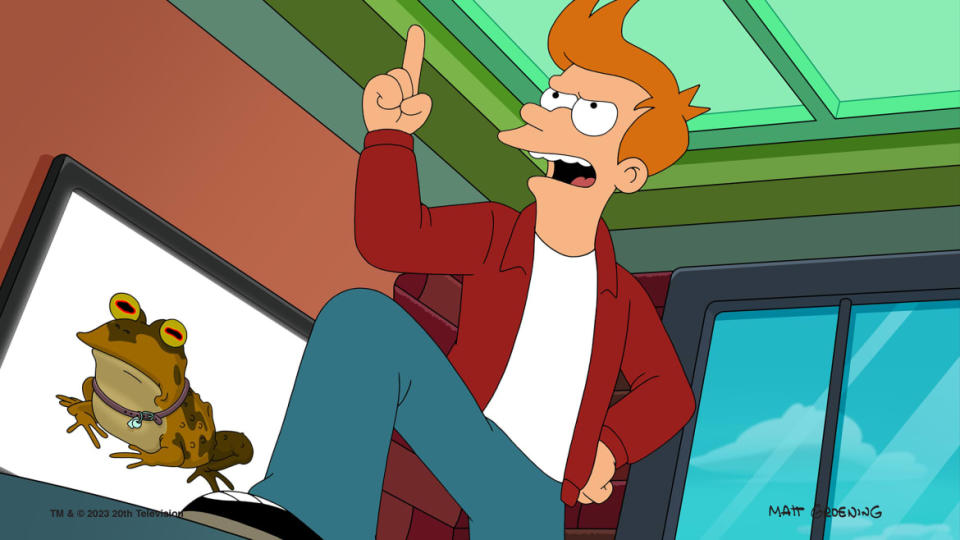
Fry risks permanent insanity when he attempts to binge-watch every TV show ever made.
Avanzino’s Rough Draft colleague and an executive producer on the show, Claudia Katz, has similar thoughts about returning to the year 3000. “I’m knocking on the wood of my desk,” she says, smiling cautiously, “but I feel like the third time may be the charm for us. It feels like the stars have finally aligned with the timing of bringing the show back. There seems to be a ton of excitement around it.”
‘Futurama’s’ Billy West on Donald Trump as Zapp Brannigan: Trump ‘Almost as Absurd’
Katz and Avanzino have both been with Futurama for every step of its wild ride. Since day one, their team has provided Groening and Cohen’s show with the lush, vibrant visuals, subtle mix of 2D and 3D animation, brilliant physical comedy, and emotion-led character work that has made it a phoenix-like fan-favorite. However, according to Katz, they very nearly weren’t involved at all.
“Futurama for us almost wasn’t,” she tells us of Rough Draft’s rough road to getting involved with the show. While Groening brought herself, Rough Draft Studios owner Greg Vanzo, and their animation director and business partner, Rich Moore, into early Futurama development discussions, the network was opposed to work with the team. “Behind the scenes, I think other parties were really pressuring Matt to go with the studio that did The Simpsons [Film Roman Inc.]. We met with the head of production at Fox who basically said to us, ‘I know you’re all talented, super artistic, and your work is A+, but there’s a two-percent chance that you’re not going to deliver the show, and I’d rather take the C- of another studio than risk the two-percent failure,’” Katz recalls. “I was flummoxed. Who would forgo a 98-percent chance of A+ success?”
Not one to give up so easily, Katz decided they needed to prove their creative chops and show the powers that be exactly why they were the right choice. Taking it upon themselves, Rough Draft Studios whipped up a short, 90-second Futurama sizzle reel and brought it to Groening.
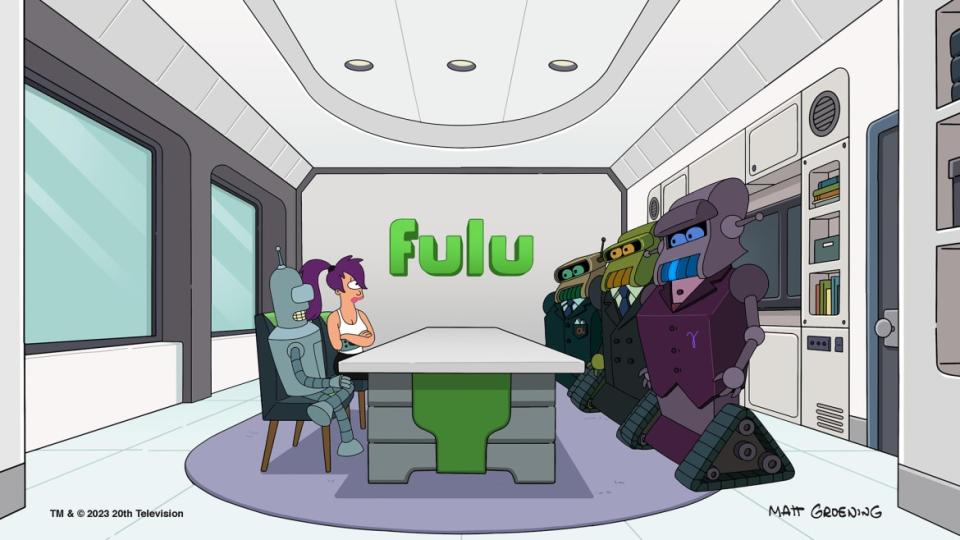
Bender and Leela in the new season of Futurama.
“He was like ‘Wow,’” she says. “Then he said, ‘Hold on a second,’ and quickly ran out of the room. It turns out, they were going to award the show to another studio that very afternoon, and he stopped that phone call from happening.” The timing of Groening’s intervention ended up changing the course of the show’s future for the better. “If it wasn’t for that happy accident, we wouldn’t have gotten the show and it wouldn’t be the same show visually—which is a big part of the series.”
Bagging the commission was only part of the battle. Now, Katz, Avanzino, and the rest of Rough Draft Studios’ artists had to actually create the show that would follow Groening’s mega-hit The Simpsons. No biggie.
‘Treehouse of Horror XXXIII’ Was the Best ‘The Simpsons’ Episode in Years
Undeterred by the Fox executives’ skepticism, the team focused on producing something audiences hadn’t seen before in traditional TV animation. “In addition to having great voice acting, jokes, and storytelling, we really had to deliver on the sci-fi elements and the only way to do that was with a 2D-3D hybrid animation,” Katz says. “We love a challenge, and it was a great opportunity to try and figure that out.”
Viewers will recognize this slick-yet-subtle style right from the series’ earliest episodes, giving extra energy to the sweeping shots of the year 3000’s New New York or any time the Planet Express starship takes flight. “We started out just using it on the ship, but by [Episode 2], we had this big reaper machine come in and actually pick Bender up,” remembers Avanzino, about how the team quickly began to test the limits of their computer-aided animation. “We were constantly figuring out what else we could do with it. Can we use it to close a door? Can we use it for a crowd?”
The team’s interest in experimentation paid off and led to the show’s unique blend of 2D and 3D animation becoming a calling card, defining its style from The Simpsons immediately. “There’s a small section of things that it helps with but it’s bigger than you think, and I really like how we’ve expanded what we can use it for, alongside ships.”
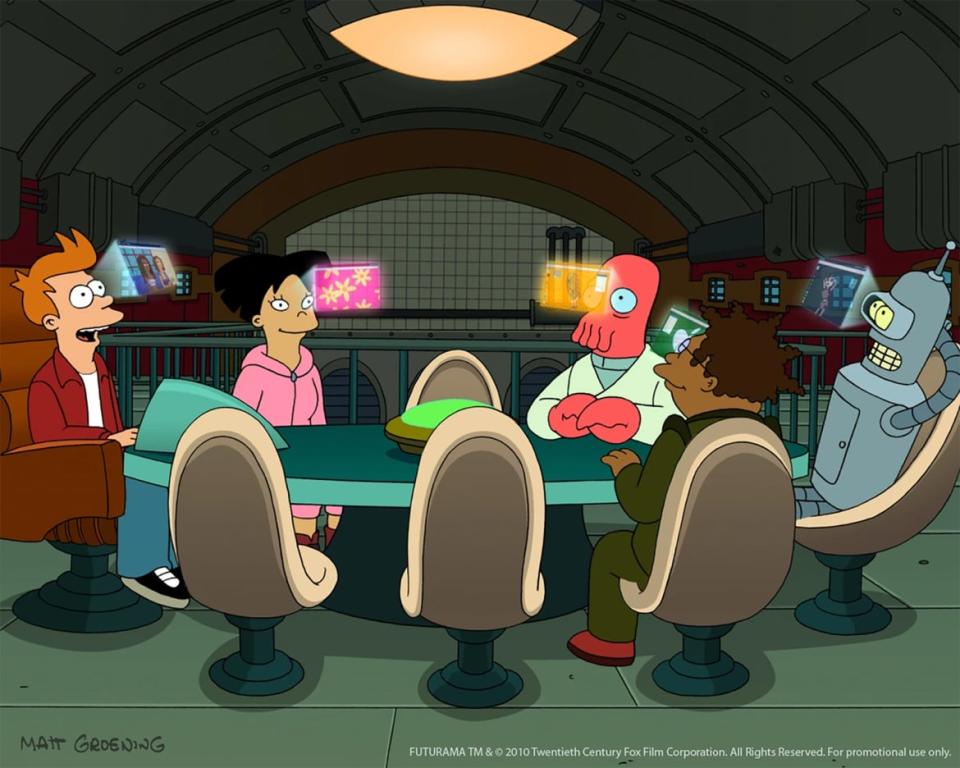
The crew gets the new 'eyePhone' inserted into their heads.
Then there’s Futurama’s many hidden secrets: in-jokes, long-running story arcs, and even alien languages and codes that are fully translatable for determined, eagle-eyed viewers. Even today, more than 20 years since the show’s debut, the team has fun threading those in. “When it comes to alien languages, or if the writers do a time-travel episode, they’ll really mathematically figure out the logic behind the storytelling,” says Katz with a smile. “For us, it’s liberating, because we just have to work on the filmmaking and the jokes. They’ve done all of the intellectual heavy lifting for us.”
While Avanzino sometimes has to keep a keen eye on his animators sneakily adding in their own gags (“I don’t need a picture of your dog on the wall,” he says), others are inserted at the request of writers, sometimes with no clear end goal in sight. “Nibbler’s shadow is in Episode 1,” Avanzino points out, referencing one of Futurama’s longest-running yet barely noticeable story arcs. “We couldn’t add something like that ourselves, because I don’t think it applies until Season 3.” That’s when Nibbler, Leela’s alien pet, reveals that he was in fact responsible for sending Fry careening into the cryo-freezer in 1999 and bringing him to the year 3000. “[The writers] came to us and said they wanted to put Nibbler’s shadow in there because they had an inkling—or maybe they knew—it had potential for something.
“When you’re talking about intricate storylines that fold back on each other, we can’t insert things like that,” he adds. “They’re all story driven.”
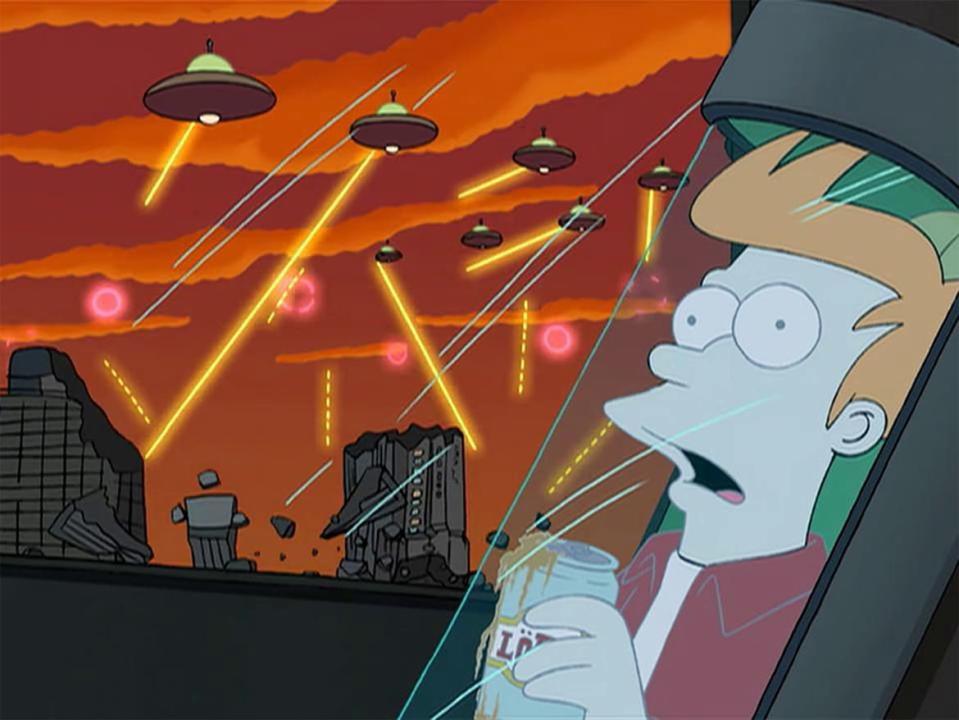
Fry in the pilot episode of Futurama from 1999.
That said, Avanzino and his team are able to elevate the show’s razor-sharp writing to powerful new places. That’s especially true when it comes to communicating emotion, something Futurama is surprisingly full of. (See: Season 4 heartbreaker “Jurassic Bark” and its hit-you-right-in-the-feels ending.)
“By the time we start, it’s a really good script read by great actors, and the emotions are there. We’re just trying to honor it, but you do have to learn to focus on what scenes to get close on,” he explains. “You’ve got to manipulate the audience, and we pride ourselves on the acting in our shows.” He offers an example of how the animation benefits those performances. “Bender doesn’t have lips,” he says of the beloved, smart-mouthed robot. “He can’t really smile or frown and only has eyebrows, but we can make him make you feel almost any way we want.”
‘Nimona’ Defied Disney to Become 2023’s Best Animated Film
Long-time viewers will be pleased to know that all of these elements reconvene in Futurama’s long-awaited new season. What’s more, with the show battling near-constant format changes since its 1999 conception—from old CRT TVs, ratio tweaks, moves into HD, and, now, 4K transitions—its new incarnation has never looked better or been packed with more blink-and-you’ll-miss-it gags. “We put some new Easter eggs in the title sequence in 4K,” reveals Katz. “There’s a whole different level of clarity now. It’s so crisp—you can really see things you’ve never seen before.” Avanzino echoes the show’s commitment to rewarding repeat visits in this latest reboot. “You can certainly see the signs that were funny from day one that you couldn’t read before.”
Despite ten years having passed since we last saw Fry, Bender, Leela, and pals, it’s refreshing how seamless it feels returning to the Futurama fold. Everything you loved about the show remains, only with bigger jokes and more elaborate adventures. “There are more big episodes in these seasons” than the previous 10, Katz says. (That number provides some confusion; while the first season of the reboot is technically the eighth production season of Futurama, it’s the 11th season by broadcast metrics.) “They ramp up pretty quickly and stay there,” she continues. “Episode 3 has a gunfight that takes place on three axes. We have an episode that took our editor over a week just to cut the dialogue track because there are around 40 characters in every scene. It’s nuts.”
Plus, for the first time in a decade, Futurama feels like it’s on solid ground. “[The Hulu team] seem to know what they have. They like and get the show which was not our experience with Fox. We’re in a place where everyone wants this to succeed and understands how special the show is,” says Katz.
As for what the future might hold? “I don’t need anything real special. Just more episodes—a constant feed of them,” says Avanzino, laughing. Meanwhile, Katz has loftier goals. “More episodes and movies” is what she wants. “Our universe is so unlimited. We can time travel and go almost anywhere. People love these characters and that would be a great progression for the series.”
Good news indeed—and with so much optimism circling Futurama’s long-awaited return, you don’t need a smell-o-scope to detect a degree of positivity and, dare we say—hope—surrounding the show’s future. Despite the TV industry seeming hellbent on exiling the Planet Express crew into an audience-free black hole, it appears this is one series that may outlive us all.
Get the Daily Beast's biggest scoops and scandals delivered right to your inbox. Sign up now.
Stay informed and gain unlimited access to the Daily Beast's unmatched reporting. Subscribe now.

